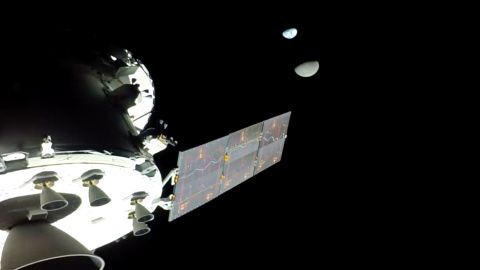NASA’s Orion spacecraft reaches record-breaking distance from Earth
Sign up for CNN’s Wonder Theory science newsletter. Explore the universe with news on fascinating discoveries, scientific advancements and more.
CNN
—
The Orion spacecraft, which is at the core of NASA’s historic Artemis I mission, reached its farthest distance from Earth Monday afternoon, shattering the record for the maximum distance a spacecraft designed to carry humans has ever traveled.
The space agency confirmed Monday evening that the Orion capsule had reached the midpoint of its uncrewed mission around the moon — about 270,000 miles (434,523 kilometers) from Earth. That’s more than 40,000 miles (64,374 kilometers) beyond the far side of the moon.
The previous record for the farthest a human-rated spacecraft has traveled was set during the Apollo 13 mission in 1970. That mission, which did actually have humans on board, stretched out to 248,655 miles (400,171 kilometers) from our home planet.
The goal of the Artemis I mission, which launched from Kennedy Space Center in Florida on November 16, is to test the Orion capsule to its limits, ensuring the vehicle is ready to safely host humans. The trial run is part of NASA’s broader Artemis program, which aims to return astronauts to the lunar surface for the first time since the 1970s.
There have been several hiccups — or “funnies,” as Artemis I Mission Manager Michael Sarafin refers to them — on this mission.
One problem was related to Orion’s star tracker, a system that uses a map of the cosmos to tell engineers on the ground how the spacecraft is oriented. Some data readings weren’t coming back as expected, but NASA officials chalked that up to a learning curve that comes with operating a new spacecraft.
“We worked through that, and there was some great leadership by the Orion team,” Sarafin said at a November 18 press conference.
Overall, however, the spacecraft’s performance has been “outstanding,” Orion Program Manager Howard Hu told reporters Monday evening. The spacecraft is outperforming expectations in some respects, such as producing about 20% more power than it really needs, he noted.
Sarafin added that things are going so well that NASA is working to add seven additional mission objectives designed to gather more data about the spacecraft’s capabilities and performance.
The spacecraft is now expected to swoop back toward the moon before firing its engines on Thursday to exit its current trajectory and head back toward Earth. The Orion capsule is on track to splash down in the Pacific Ocean off the coast of California on December 11.

“Artemis I has had extraordinary success and has completed a series of history-making events,” NASA Administrator Bill Nelson said Monday. “Since the launch, we have been receiving critical data back and there’s a lot more to come. … The biggest test after the launch is the reentry because we want to know that that heat shield…
Read More: NASA’s Orion spacecraft reaches record-breaking distance from Earth
